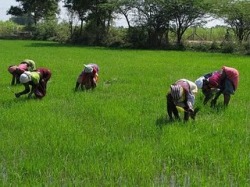
Chennai: If sowing intentions of farmers are any indication, then the upcoming kharif season is likely to witness a changing pattern in the coverage of various crops. Growers could shift to cash and remunerative crops.
Upper most in the minds of the farmers is the price they are likely to get when their crops are harvested. The other factors that can influence the kharif sowing pattern are huge carryover stocks as in the case of oilseeds and maize.
A normal monsoon is likely to see the area under rice returning to usual levels. But it is likely that farmers will not go in for pusa 1121 aggressively like last year. Farmers growing this aromatic variety are seen shifting to traditional basmati rice or even sugarcane in some cases.
Notwithstanding the ban on cotton exports, the area under the natural fibre is set to gain. This is in view of the good domestic demand that is seen keeping cotton prices at current highs.
In fact, cotton could gain at the cost of crops such as groundnut in Gujarat. Oilseeds coverage may fall this year. A major reason is the nearly 20 million tonnes of uncrushed seeds. Some farmers in Madhya Pradesh, the soyabean hub of the country, say that nearly half of what they produced last year is still with them.
In Gujarat, the poor yield of last year is turning growers away from groundnut to cotton, jeera and amaranth. Coarse cereals could lose out to remunerative pulses. A fall in maize (corn) exports from the levels witnessed in the last two years and huge stocks with growers are likely to force a change in favour of pulses or guar.
Pulses crops such as moong and urad are seen gaining because of the current market prices that are seen very attractive.
Source: The Hindu Business Line
Upper most in the minds of the farmers is the price they are likely to get when their crops are harvested. The other factors that can influence the kharif sowing pattern are huge carryover stocks as in the case of oilseeds and maize.
A normal monsoon is likely to see the area under rice returning to usual levels. But it is likely that farmers will not go in for pusa 1121 aggressively like last year. Farmers growing this aromatic variety are seen shifting to traditional basmati rice or even sugarcane in some cases.
Notwithstanding the ban on cotton exports, the area under the natural fibre is set to gain. This is in view of the good domestic demand that is seen keeping cotton prices at current highs.
In fact, cotton could gain at the cost of crops such as groundnut in Gujarat. Oilseeds coverage may fall this year. A major reason is the nearly 20 million tonnes of uncrushed seeds. Some farmers in Madhya Pradesh, the soyabean hub of the country, say that nearly half of what they produced last year is still with them.
In Gujarat, the poor yield of last year is turning growers away from groundnut to cotton, jeera and amaranth. Coarse cereals could lose out to remunerative pulses. A fall in maize (corn) exports from the levels witnessed in the last two years and huge stocks with growers are likely to force a change in favour of pulses or guar.
Pulses crops such as moong and urad are seen gaining because of the current market prices that are seen very attractive.
Source: The Hindu Business Line
 RSS Feed
RSS Feed